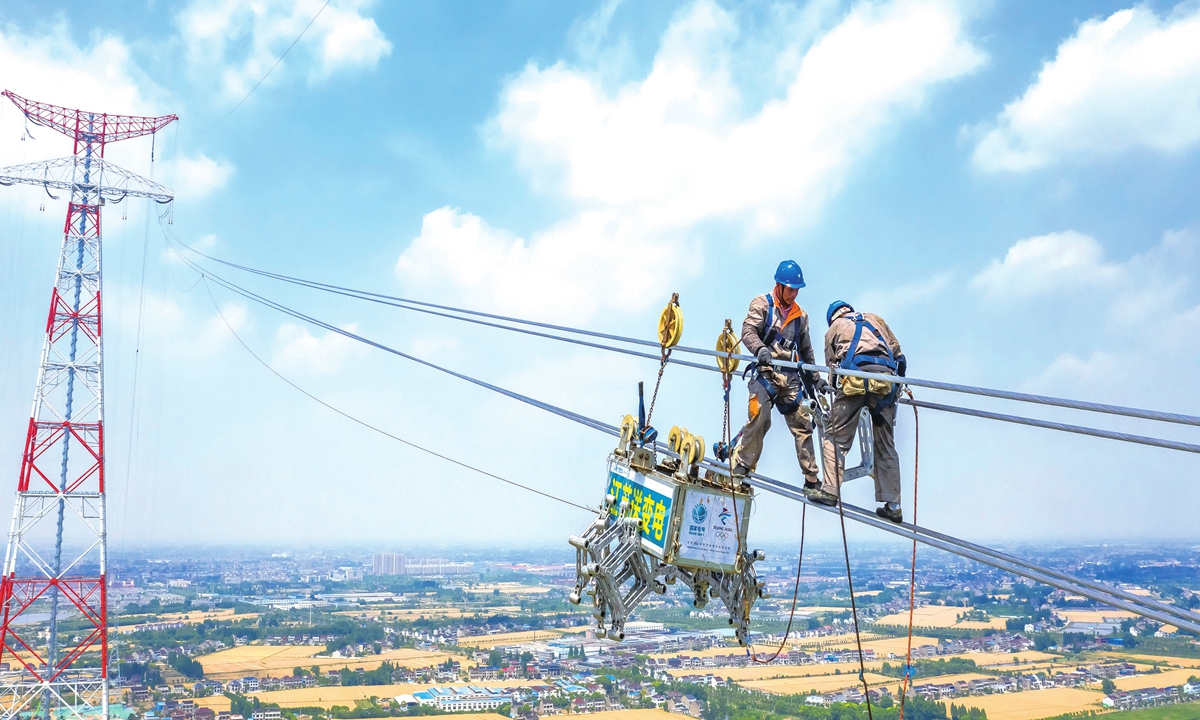
Construction site of the Yangtze River crossing pathway project for the new 500-kilovolt transmission line in East China's Jiangsu Province on June 1, 2022. Running from Fengcheng to Meili, the line will further support the integration of energy and electricity in the Yangtze River Delta. Photo: cnsphoto
China's electricity use, a key barometer of economic activity, accelerated in March as the nation's post-pandemic rebound gathered momentum, prompting manufacturers to maximize production and inspiring consumer confidence.
Power use in March jumped by 5.9 percent, more than double the gain in the first two months of the year, indicating that the pace of economic recovery is picking up, according to China Central Television, citing data from the National Energy Administration (NEA).
Of the country's 34 provinces and municipalities, 26 recorded higher power use in March on a yearly basis.
In East China's Zhejiang Province, a manufacturing powerhouse, eight of 11 industries' power use grew. The contribution of industrial electricity use to the growth of total electricity use reached 40.66 percent in March, and electricity use by the manufacturing sector rose to a near record high, NEA data showed.
"Electricity consumption is a key indicator of the real economy's performance. Its growth proves the nation's economy is rebounding as widely expected," Liu Ying, a research fellow at the Chongyang Institute for Financial Studies at Renmin University of China, told the Global Times on Monday.
In certain industries, the rebound is becoming more obvious, according to Liu. "All industries are ready for a sprint."
Energy consumption is more than a gauge of the macro-economy - it also reflects China's ongoing structural energy transformation, experts said.
Power use by the high-technology and equipment manufacturing sectors grew significantly in the first quarter. In March alone, power use by photovoltaic equipment and component makers in East China's Jiangsu Province, an economic powerhouse, increased by 66.1 percent year-on-year, and that of new-energy vehicle (NEV) producers rose by 62.1 percent.
"The big increase in emerging industries like NEVs indicates that China's manufacturing sector is continuously marching toward green and high quality" operations, Dong Dengxin, director of the Finance and Securities Institute of the Wuhan University of Science and Technology, told the Global Times on Monday.
China's electricity use will reach 9.15 trillion kilowatt-hours (kW/hr) in 2023 under normal climate conditions, up 6 percent year-on-year, driven by the overall recovery of the economy, according to a report by the China Electricity Council (CEC). Growth is expected to pick up significantly in the second quarter.
Power use increased 3.6 percent year-on-year to 8.64 trillion kW/hr last year, according to NEA data.
The CEC's forecast is in line with economists' predictions for the second-quarter growth. They're expecting at least 5 percent expansion, considering the low base last year and the driving effect of the just-ended May Day holidays, during which both domestic trips and tourism revenue surpassed the 2019 pre-COVID levels.
GDP grew by 4.5 percent in the first quarter, with consumption contributing around two-thirds of economic output. In March alone, retail sales jumped 10.6 percent year-on-year, data from the National Bureau of Statistics showed.
"Compared with the start of the year when China's COVID-related measures had just been lifted, the second quarter will witness a further revival of economic activity, marked by rising flows of people and goods," Liu said.
This outlook contrasts with remarks by some firms that predict a "moderating" pace in their China business growth.
While China's economic recovery was better than expected, growth in average weekly sales there will be at a more moderate pace in the second half, Chief Financial Officer Rachel Ruggeri of US coffeehouse chain Starbucks said during an earnings call in early May, according to a Reuters report.
Economists and international organizations widely have a bright outlook for China's economic growth this year, with most anticipating a 5-6 percent GDP expansion despite external pressures, which would put the world's second-largest economy on track to become one of the fastest-growing major economies this year.
JPMorgan raised its 2023 growth outlook for China to 6.4 percent, from a previous forecast of 6 percent, saying the first-quarter data pointed to further growth ahead.
The robust rebound means China is set to account for around one-third of global growth in 2023 - giving a welcome lift to the world economy, Kristalina Georgieva, IMF managing director, said at the 2023 China Development Forum in March.
Liu estimated that following the first-quarter rebound, China's contribution to the world's economy is expected to exceed 40 percent this year.




